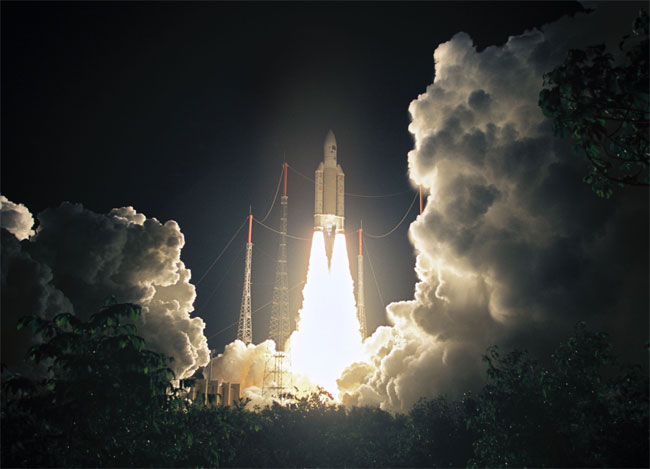Ariane 5 GS Lofts Indian, European Satellites into Orbit

DARMSTADT,Germany -- Europe's Ariane 5 GS rocket successfully placed an Indiantelecommunications satellite and a European weather satellite into orbit Dec.21, marking the first time the heavy-lift rocket has conducted five launchesin a calendar year.
The launchof the Indian Space Research Organization's Insat 4A telecommunicationssatellite inaugurates a new generation of domestic communications spacecraft.Insat 4A will be used for Indian domestic governmental and commercialtelecommunications. Its 12 Ku-band transponders have already been sold todirect-broadcast television companies serviing India, an illustration of the surgingdemand for satellite television in the subcontinent. The satellite also carries12 C-band transponders.
It is ademand that several commercial satellite-fleet operators would like to serve.But India has a policy of obligingdirect-broadcast satellite television companies to use India's satellites unless thosesatellites are full. The Indian Space Research Organization plans three moreInsat 4 satellites for launch by the end of 2008.
The launchof the Metosat 9 satellite -- called MSG-2 before launch--for Europe's meteorological satelliteorganization, the 18 nation Eumetsat, will give Europe a backup satellite to join itstwin, Meteosat 8, which is already operational. These two satellites are thefirst of the four Meteosat Second Generation spacecraft, which provide imageryfrom 12 spectral channels every 15 minutes.
The fourMeteosat Second Generation satellites will provide climate and weather datathrough 2018. The total program is valued at 2 billion euros ($2.36 billion),including the the production, launch and operations of the four satellites.
- Revamped Ariane 5 Rocket Can Boost Bigger Payload
- Ariane-5: The New European Rocket
- Ariane 5 ECA Will Boost Arianespace Capabilities
Get the Space.com Newsletter
Breaking space news, the latest updates on rocket launches, skywatching events and more!
Join our Space Forums to keep talking space on the latest missions, night sky and more! And if you have a news tip, correction or comment, let us know at: community@space.com.

Charles Q. Choi is a contributing writer for Space.com and Live Science. He covers all things human origins and astronomy as well as physics, animals and general science topics. Charles has a Master of Arts degree from the University of Missouri-Columbia, School of Journalism and a Bachelor of Arts degree from the University of South Florida. Charles has visited every continent on Earth, drinking rancid yak butter tea in Lhasa, snorkeling with sea lions in the Galapagos and even climbing an iceberg in Antarctica. Visit him at http://www.sciwriter.us









